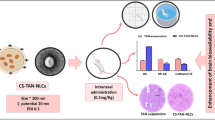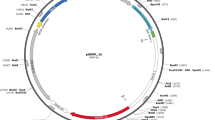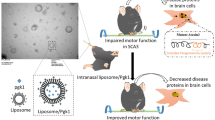Abstract
Parkinson’s disease (PD) is the second most common neurodegenerative disorder (ND), characterized by the loss of dopaminergic neurons, microglial activation, and neuroinflammation. Current available treatments in clinical practice cannot halt the progression of the disease. During the last few years, growth factors (GFs) have been raised as a promising therapeutic approach to address the underlying neurodegenerative process. Among others, glial cell-derived neurotrophic factor (GDNF) is a widely studied GF for PD. However, its clinical use is limited due to its short half life, rapid degradation rate, and difficulties in crossing the blood-brain barrier (BBB). Lately, intranasal administration has appeared as an alternative non-invasive way to bypass the BBB and target drugs directly to the central nervous system (CNS). Thus, the aim of this work was to develop a novel nanoformulation to enhance brain targeting in PD through nasal administration. For that purpose, GDNF was encapsulated into chitosan (CS)-coated nanostructured lipid carriers, with the surface modified with transactivator of transcription (TAT) peptide (CS-nanostructured lipid carrier (NLC)-TAT-GDNF). After the physiochemical characterization of nanoparticles, the in vivo study was performed by intranasal administration to a 1-methyl-4-phenyl-1,2,3,6-tetrahydropyridine (MPTP) mouse model of PD. The CS-NLC-TAT-GDNF-treated group revealed motor recovery which was confirmed with immunohistochemistry studies, showing the highest number of tyrosine hydroxylase (TH+) fibers in the striatum and TH+ neuron levels in the substantia nigra. Moreover, ionizing calcium-binding adaptor molecule 1 immunohistochemistry was performed, revealing that CS-NLC-TAT-GDNF acts as a modulator on microglia activation, obtaining values similar to control. Therefore, it may be concluded that the intranasal administration of CS-NLC-TAT-GDNF may represent a promising therapy for PD treatment.






Similar content being viewed by others
References
Lees AJ, Hardy J, Revesz T (2009) Parkinson’s disease. Lancet 373:2055–2066. doi:10.1016/S0140-6736(09)60492-X
Nussbaum RL, Ellis CE (2003) Alzheimer’s disease and Parkinson’s disease. N Engl J Med 348:1356–1364. doi:10.1056/NEJM2003ra020003
Kalia LV, Lang AE (2015) Parkinson’s disease. Lancet 386:896–912. doi:10.1016/S0140-6736(14)61393-3
Hirsch EC, Hunot S (2009) Neuroinflammation in Parkinson’s disease: a target for neuroprotection? Lancet Neurol 8:382–397. doi:10.1016/S1474-4422(09)70062-6
Joers V, Tansey MG, Mulas G, Carta AR (2016) Microglial phenotypes in Parkinson’s disease and animal models of the disease. Prog Neurobiol. doi:10.1016/j.pneurobio.2016.04.006
Long-Smith CM, Sullivan AM, Nolan YM (2009) The influence of microglia on the pathogenesis of Parkinson’s disease. Prog Neurobiol 89:277–287. doi:10.1016/j.pneurobio.2009.08.001
Oertel W, Schulz JB (2016) Current and experimental treatments of Parkinson disease: a guide for neuroscientists. J Neurochem 139(Suppl 1):325–337. doi:10.1111/jnc.13750
Allen SJ, Watson JJ, Shoemark DK, Barua NU, Patel NK (2013) GDNF, NGF and BDNF as therapeutic options for neurodegeneration. Pharmacol Ther 138:155–175. doi:10.1016/j.pharmthera.2013.01.004
Sullivan AM, Toulouse A (2011) Neurotrophic factors for the treatment of Parkinson’s disease. Cytokine Growth Factor Rev 22:157–165. doi:10.1016/j.cytogfr.2011.05.001
Lapchak PA, Gash DM, Jiao S, Miller PJ, Hilt D (1997) Glial cell line-derived neurotrophic factor: a novel therapeutic approach to treat motor dysfunction in Parkinson’s disease. Exp Neurol 144:29–34. doi:10.1006/exnr.1996.6384
Gill SS, Patel NK, Hotton GR, O’Sullivan K, McCarter R, Bunnage M, Brooks DJ, Svendsen CN et al (2003) Direct brain infusion of glial cell line-derived neurotrophic factor in Parkinson disease. Nat Med 9:589–595. doi:10.1038/nm850
Lang AE, Gill S, Patel NK et al (2006) Randomized controlled trial of intraputamenal glial cell line-derived neurotrophic factor infusion in Parkinson disease. Ann Neurol 59:459–466. doi:10.1002/ana.20737
Nutt JG, Burchiel KJ, Comella CL, Jankovic J, Lang AE, Laws ER Jr, Lozano AM, Penn RD et al, ICV GDNF Study Group. Implanted intracerebroventricular. Glial cell line-derived neurotrophic factor (2003) Randomized, double-blind trial of glial cell line-derived neurotrophic factor (GDNF) in PD. Neurology 60:69–73
Salvatore MF, Ai Y, Fischer B, Zhang AM, Grondin RC, Zhang Z, Gerhardt GA, Gash DM (2006) Point source concentration of GDNF may explain failure of phase II clinical trial. Exp Neurol 202:497–505
Tajes M, Ramos-Fernandez E, Weng-Jiang X, Bosch-Morato M, Guivernau B, Eraso-Pichot A, Salvador B, Fernandez-Busquets X et al (2014) The blood-brain barrier: structure, function and therapeutic approaches to cross it. Mol Membr Biol 31:152–167. doi:10.3109/09687688.2014.937468
Djupesland PG, Messina JC, Mahmoud RA (2014) The nasal approach to delivering treatment for brain diseases: an anatomic, physiologic, and delivery technology overview. Ther Deliv 5:709–733. doi:10.4155/tde.14.41
Costantino HR, Illum L, Brandt G, Johnson PH, Quay SC (2007) Intranasal delivery: physicochemical and therapeutic aspects. Int J Pharm 337:1–24. doi:10.1016/j.ijpharm.2007.03.025
Re F, Gregori M, Masserini M (2012) Nanotechnology for neurodegenerative disorders. Maturitas 73:45–51. doi:10.1016/j.maturitas.2011.12.015
Shah B, Khunt D, Bhatt H, Misra M, Padh H (2015) Application of quality by design approach for intranasal delivery of rivastigmine loaded solid lipid nanoparticles: effect on formulation and characterization parameters. Eur J Pharm Sci 78:54–66. doi:10.1016/j.ejps.2015.07.002
Sharma S, Lohan S, Murthy RSR (2013) Formulation and characterization of intranasal mucoadhesive nanoparticulates and thermo-reversible gel of levodopa for brain delivery. Drug Dev Ind Pharm 40:869–878. doi:10.3109/03639045.2013.789051
Zhang C, Chen J, Feng C, Shao X, Liu Q, Zhang Q, Pang Z, Jiang X (2014) Intranasal nanoparticles of basic fibroblast growth factor for brain delivery to treat Alzheimer’s disease. Int J Pharm 461:192–202. doi:10.1016/j.ijpharm.2013.11.049
Md S, Khan RA, Mustafa G, Chuttani K, Baboota S, Sahni JK, Ali J (2013) Bromocriptine loaded chitosan nanoparticles intended for direct nose to brain delivery: pharmacodynamic, pharmacokinetic and scintigraphy study in mice model. Eur J Pharm Sci 48:393–405. doi:10.1016/j.ejps.2012.12.007
Mistry A, Glud SZ, Kjems J, Randel J, Howard KA, Stolnik S, Illum L (2009) Effect of physicochemical properties on intranasal nanoparticle transit into murine olfactory epithelium. J Drug Target 17:543–552. doi:10.1080/10611860903055470
Fazil M, Md S, Haque S, Kumar M, Baboota S, Jk S, Ali J (2012) Development and evaluation of rivastigmine loaded chitosan nanoparticles for brain targeting. Eur J Pharm Sci 47:6–15. doi:10.1016/j.ejps.2012.04.013
Zhao Y, Li X, Lu C, Lin M, Chen L, Xiang Q, Zhang M, Jin R et al (2014) Gelatin nanostructured lipid carriers-mediated intranasal delivery of basic fibroblast growth factor enhances functional recovery in hemiparkinsonian rats. Nanomedicine 10:755–764. doi:10.1016/j.nano.2013.10.009
Jafarieh O, Md S, Ali M, Baboota S, Sahni JK, Kumari B, Bhatnagar A, Ali J (2015) Design, characterization, and evaluation of intranasal delivery of ropinirole-loaded mucoadhesive nanoparticles for brain targeting. Drug Dev Ind Pharm 41:1674–1681. doi:10.3109/03639045.2014.991400
Gartziandia O, Herran E, Pedraz JL, Carro E, Igartua M, Hernandez RM (2015) Chitosan coated nanostructured lipid carriers for brain delivery of proteins by intranasal administration. Colloids Surf B Biointerfaces 134:304–313. doi:10.1016/j.colsurfb.2015.06.054
Qin Y, Chen H, Zhang Q, Wang X, Yuan W, Kuai R, Tang J, Zhang L et al (2011) Liposome formulated with TAT-modified cholesterol for improving brain delivery and therapeutic efficacy on brain glioma in animals. Int J Pharm 420:304–312. doi:10.1016/j.ijpharm.2011.09.008
Kanazawa T, Akiyama F, Kakizaki S, Takashima Y, Seta Y (2013) Delivery of siRNA to the brain using a combination of nose-to-brain delivery and cell-penetrating peptide-modified nano-micelles. Biomaterials 34:9220–9226. doi:10.1016/j.biomaterials.2013.08.036
Gartziandia O, Egusquiaguirre SP, Bianco J, Pedraz JL, Igartua M, Hernandez RM, Préat V, Beloqui A (2016) Nanoparticle transport across in vitro olfactory cell monolayers. Int J Pharm 499:81–89. doi:10.1016/j.ijpharm.2015.12.046
Egusquiaguirre SP, Manguán-García C, Pintado-Berninches L et al (2015) Development of surface modified biodegradable polymeric nanoparticles to deliver GSE24.2 peptide to cells: a promising approach for the treatment of defective telomerase disorders. Eur J Pharm Biopharm 91:91–102. doi:10.1016/j.ejpb.2015.01.028
Anitua E, Pascual C, Pérez-Gonzalez R, Orive G, Carro E (2015) Intranasal PRGF-Endoret enhances neuronal survival and attenuates NF-κB-dependent inflammation process in a mouse model of Parkinson’s disease. J Control Release 203:170–180. doi:10.1016/j.jconrel.2015.02.030
Blandini F, Armentero MT (2012) Animal models of Parkinson’s disease. FEBS J 279:1156–1166. doi:10.1111/j.1742-4658.2012.08491.x
Kalia LV, Kalia SK, Lang AE (2015) Disease-modifying strategies for Parkinson’s disease. Mov Disord 30:1442–1450. doi:10.1002/mds.26354
Herran E, Requejo C, Ruiz-Ortega JA et al (2014) Increased antiparkinson efficacy of the combined administration of VEGF- and GDNF-loaded nanospheres in a partial lesion model of Parkinson’s disease. Int J Nanomedicine 9:2677–2687
Herrán E, Ruiz-Ortega JÁ, Aristieta A, Igartua M, Requejo C, Lafuente JV, Ugedo L, Pedraz JL et al (2013) In vivo administration of VEGF- and GDNF-releasing biodegradable polymeric microspheres in a severe lesion model of Parkinson’s disease. Eur J Pharm Biopharm 85:1183–1190. doi:10.1016/j.ejpb.2013.03.034
Garbayo E, Montero-Menei CN, Ansorena E, Lanciego JL, Aymerich MS, Blanco-Prieto MJ (2009) Effective GDNF brain delivery using microspheres—a promising strategy for Parkinson’s disease. J Control Release 135:119–126. doi:10.1016/j.jconrel.2008.12.010
Garbayo E, Ansorena E, Lanciego JL, Blanco-Prieto MJ, Aymerich MS (2011) Long-term neuroprotection and neurorestoration by glial cell-derived neurotrophic factor microspheres for the treatment of Parkinson’s disease. Mov Disord 26:1943–1947. doi:10.1002/mds.23793
Jollivet C, Aubert-Pouessel A, Clavreul A, Venier-Julienne M, Remy S, Montero-Menei CN, Benoit J, Menei P (2004) Striatal implantation of GDNF releasing biodegradable microspheres promotes recovery of motor function in a partial model of Parkinson’s disease. Biomaterials 25:933–942. doi:10.1016/S0142-9612(03)00601-X
Gartziandia O, Herrán E, Ruiz-Ortega JA, Miguelez C, Igartua M, Lafuente JV, Pedraz JL, Ugedo L et al (2016) Intranasal administration of chitosan-coated nanostructured lipid carriers loaded with GDNF improves behavioral and histological recovery in a partial lesion model of Parkinson’s disease. J Biomed Nanotechnol 12:1–11. doi:10.1166/jbn.2016.2313
Schober A (2004) Classic toxin-induced animal models of Parkinson’s disease: 6-OHDA and MPTP. Cell Tissue Res 318:215–224. doi:10.1007/s00441-004-0938-y
Blesa J, Przedborski S (2014) Parkinso’s disease: animal models and dopaminergic cell vulnerability. Front Neuroanat 8:155. doi:10.3389/fnana.2014.00155
Barker RA (2009) Parkinson’s disease and growth factors—are they the answer? Parkinsonism Relat Disord 15(Supplement 3):S181–S184. doi:10.1016/S1353-8020(09)70810-7
Chang YP, Fang KM, Lee TI, Tzeng SF (2006) Regulation of microglial activities by glial cell line derived neurotrophic factor. J Cell Biochem 97:501–511. doi:10.1002/jcb.20646
Rocha SM, Cristovão AC, Campos FL, Fonseca CP, Baltazar G (2012) Astrocyte-derived GDNF is a potent inhibitor of microglial activation. Neurobiol Dis 47:407–415. doi:10.1016/j.nbd.2012.04.014
Rickert U, Grampp S, Wilms H, Spreu J, Knerlich-Lukoschus F, Held-Feindt J, Lucius R (2014) Glial cell line-derived neurotrophic factor family members reduce microglial activation via inhibiting p38MAPKs-mediated inflammatory responses. J Neurodegener Dis 2014:369468. doi:10.1155/2014/369468
Liberatore GT, Jackson-Lewis V, Vukosavic S, Mandir AS, Vila M, McAuliffe WG, Dawson VL, Dawson TM et al (1999) Inducible nitric oxide synthase stimulates dopaminergic neurodegeneration in the MPTP model of Parkinson disease. Nat Med 5:1403–1409. doi:10.1038/70978
Langston JW, Forno LS, Tetrud J, Reeves AG, Kaplan JA, Karluk D (1999) Evidence of active nerve cell degeneration in the substantia nigra of humans years after 1-methyl-4-phenyl-1,2,3,6-tetrahydropyridine exposure. Ann Neurol 46:598–605
McGeer PL, Schwab C, Parent A, Doudet D (2003) Presence of reactive microglia in monkey substantia nigra years after 1-methyl-4-phenyl-1,2,3,6-tetrahydropyridine administration. Ann Neurol 54:599–604. doi:10.1002/ana.10728
Lawson LJ, Perry VH, Dri P, Gordon S (1990) Heterogeneity in the distribution and morphology of microglia in the normal adult mouse brain. Neuroscience 39:151–170. doi:10.1016/0306-4522(90)90229-W
Mogi M, Kondo T, Mizuno Y, Nagatsu T (2007) p53 protein, interferon-γ, and NF-κB levels are elevated in the parkinsonian brain. Neurosci Lett 414:94–97. doi:10.1016/j.neulet.2006.12.003
Acknowledgements
This project was partially supported by the “Ministerio de Economía y Competitividad” (SAF2013-42347-R), the University of the Basque Country (UPV/EHU) (UFI 11/32), and the FEDER funds. The authors thank SGIker of UPV/EHU and European funding (ERDF and ESF) for technical and human support. The authors also wish to thank the intellectual and technical assistance from the ICTS “NANBIOSIS”, more specifically by the Drug Formulation Unit (U10) of the CIBER-BBN at the UPV/EHU.
Author information
Authors and Affiliations
Corresponding author
Rights and permissions
About this article
Cite this article
Hernando, S., Herran, E., Figueiro-Silva, J. et al. Intranasal Administration of TAT-Conjugated Lipid Nanocarriers Loading GDNF for Parkinson’s Disease. Mol Neurobiol 55, 145–155 (2018). https://doi.org/10.1007/s12035-017-0728-7
Published:
Issue Date:
DOI: https://doi.org/10.1007/s12035-017-0728-7




